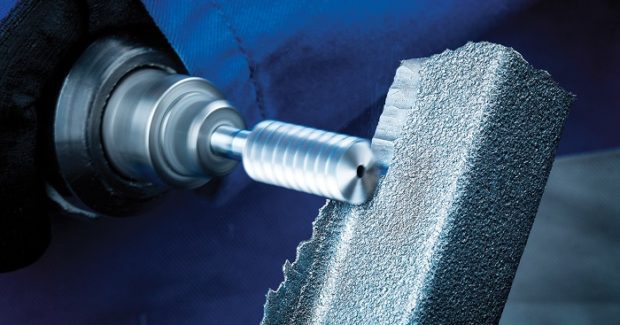How to Significantly Increase Metal Removal Rates on Cast Iron
Innovative tooth geometry on the high performance Cast Cut carbide bur from PFERD can increase metal removal rates by up to 100 percent in automotive, foundry, welding, and general industry applications.
Posted: March 19, 2019
Characterized by an extremely high stock removal rate coupled with a smooth milling action that significantly reduces vibration and noise, the Cast Cut line of high-performance carbide burs from PFERD Inc. (Milwaukee, WI) is specially designed for work on cast iron. They achieve stock removal rates up to 100 percent higher than conventional double cut burs thanks to their innovative tooth geometry, which is a major plus for automotive applications that must boost productivity and save time, as well as foundry, welding and general industry applications. Cast Cut is optimized for coarse stock removal on all types of black, grey and white cast iron. With a cutting speed in the 1,500 sfm to 2,500 sfm range (rotational speed of 12,000 rpm to 20,000 rpm), it has an aggressive cutting action that results in large chips and good chip removal which, combined with its high metal removal rate, produces optimum results in the shortest possible time. Available in five standard SCTI shapes with a shank diameter of ¼ in, this carbide bur is energy-efficient and reduces waste. Its reduced vibration and lower noise contribute to a fatigue-free, high efficiency working environment.
For cleaning and light deburring, miniature brushes from PFERD give users a competitive advantage by providing highly repeatable deburring and surface-conditioning results on a variety of materials, from hard alloys to soft aluminum. The lineup of wheel, cup and end configurations includes stem-mounted miniature brushes that are ideally suited for the precision applications required in many industries, including electronics, medical, aerospace and jewelry. These brushes are available with a wide selection of filaments, including carbon steel wire, stainless steel, brass wire, aluminum oxide abrasive filament and a variety of soft or stiff natural bristles. All of the stem-mounted miniature brushes are mounted on 1/8 in stems and are recommended for use with variable speed die grinders. Wheel brushes come in diameters up to 1½ in, cup in 9/16 in diameter and end configuration to 5/16 in diameter.
The innovative M-BRAD® brush is available as an aluminum oxide filament is a 6.12 nylon microfilament that evenly encapsulates various abrasive grit particles on the surface as well as throughout the nylon filament. The flexibility of strands makes it uniquely effective when deburring complex parts. It yields consistent gradual cutting action, permitting precise control in applications ranging from cosmetic surface preparation on brass or soft aluminum, to edge blending on materials as tough as titanium and carbide. These are also effective on materials such as wood or glass. These brushes yield longer tool life than non-woven synthetic abrasives and are suitable for both wet and dry surface conditioning, although the use of coolant is recommended. The effective cleaning action of these brushes removes sharp cross-hole burrs, metal sliver residues and sharp corners that result from the drilling of close-tolerance hard metallic and non-metallic parts.
PFERD Inc., 9201 West Heather Avenue, Milwaukee, WI 53224, 800-342-9015, www.pferdusa.com.





